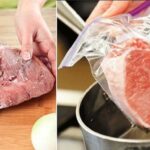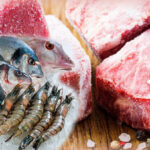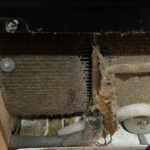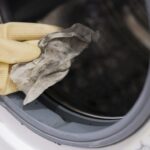Placing Hot Food in the Refrigerator
Putting hot food in the fridge increases the internal temperature, putting strain on the cooling system and potentially damaging it. It also raises the surrounding temperature, affecting the preservation of other foods and increasing the risk of cross-contamination.
Not Cleaning the Fridge Regularly
The refrigerator, housing various foods, easily harbors bacteria and unpleasant odors. A lack of cleaning encourages bacterial growth. Many believe that low temperatures prevent bacterial growth, but this is incorrect.
Therefore, regular cleaning is necessary to prevent odors from diminishing the quality and taste of food and to inhibit bacterial growth. This is especially important if your fridge stores both raw and cooked foods.

Mixing raw and cooked food in the fridge can lead to cross-contamination.
Mixing Raw and Cooked Food
When storing food in the fridge, use separate compartments for raw and cooked items, and wrap or cover food. Mixing them can lead to bacterial spread and cross-contamination. Many raw foods, such as poultry, pork, and fresh produce, harbor dangerous bacteria that can easily transfer to cooked dishes, posing a health risk to your family.
Not Adjusting the Temperature Control
The temperature settings should be adjusted based on the amount and type of food in the fridge. The ideal temperature for the fridge is 3 to 4 degrees Celsius, and for the freezer, it’s -18 degrees Celsius. Improper temperatures not only impact food quality but also increase energy consumption and compromise food safety.

Adjust the temperature accordingly.
Leaving the Fridge Door Open for Too Long or Opening It Frequently
When taking food out of the fridge, be quick and minimize the number of times the door is opened. This not only saves energy but also maintains the preservation temperature, ensuring food stays fresh. Leaving the door open allows bacteria to enter and affect the stored food.
Placing the Fridge Near a Window
Positioning the fridge near a window risks exposure to rain, wind, and direct sunlight, leading to increased energy consumption and a rise in surrounding temperatures, which impacts food preservation. Additionally, rain exposure may result in electrical hazards such as short circuits or fires.
Keeping the Fridge Close to the Stove
Placing the fridge near the stove increases the surrounding temperature, hindering the fridge’s ability to maintain low temperatures efficiently. This setup also leads to higher energy consumption. It is best to position the fridge away from the stove and maintain a distance from walls to allow for better heat dissipation. Ensure the fridge is placed in a stable and secure location.
The Ultimate Guide to Thawing Frozen Foods for Tet: Preserve Nutrients, Taste, and Quality
The great freezer conundrum: a challenge faced by many. Meat, fish, and shrimp are often stashed away in the icy depths of freezers, but the age-old question remains – how best to thaw? Forget the old wives’ tales of hot water, salty ice baths, or leaving food to defrost at room temperature. It’s time to embrace a new era of thawing wisdom and discover the optimal method that will revolutionize your culinary adventures.



































